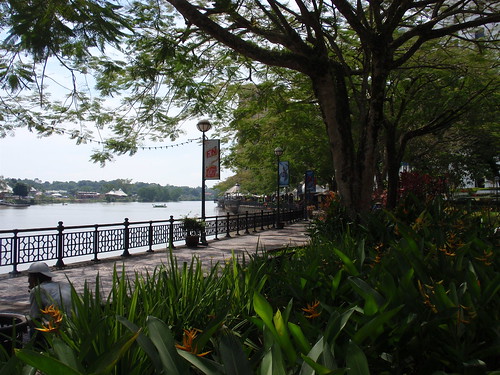
Kuching spans the Sarawak River, and there's a wonderful riverfront walk with luxuriant tropical gardens along one side of the river. This means we can stroll into the old city centre along the Main Bazaar without having to deal with traffic and the usual busyness of a city.
Kuching's not an old city. Well into the nineteenth century Sarawak was inhabited by people of different language and cultural groups - some, such as the Penan were hunter-gatherers; others such as the Dayaks lived in extended families in longhouses and were renowned for the ferocity of their warriors. The British explorer James Brooke sailed into the Sarawak River in 1839 and by 1841 had become the first 'white rajah' of the area. He encouraged Chinese immigration to provide trade and labour for the community. Even today Kuching is a culturally diverse city with Malays, Chinese and indigneous peoples in roughly equal proportions.
Some of this diversity is reflected in the architecture and streetscapes of Kuching. There are buildings from the colonial period, the most beautiful of which is the stately Courthouse complex with its solid pillars and wide shady verandahs:

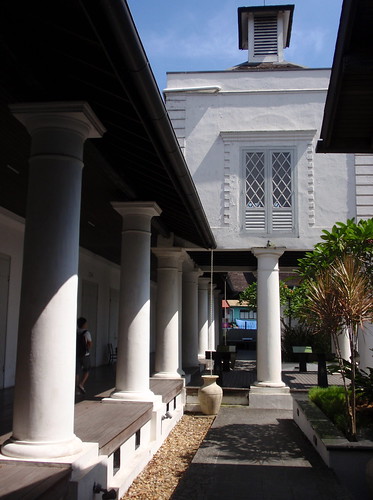
The buildings are still partly used as a court, but also now house the Sarawak Tourism Board - probably the most beautiful tourist information office I've ever been in. Next door is the ornate Pavilion building whose chequered history includes use as a hospital when it was built in the early 1900s and then later as an information and propaganda centre during the Japanese occupation during the second work war. It's recently been converted to a lovely textile museum with examples of the rich, wonderful, old and more recent textiles from the groups of people who inhabit Sarawak.
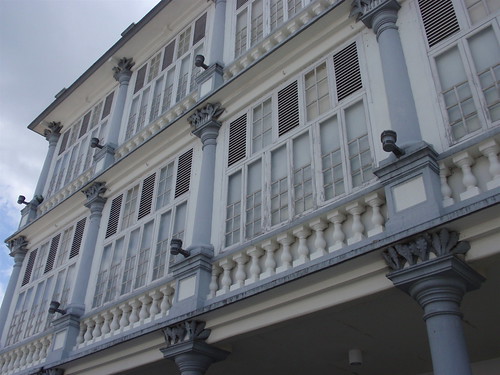
There are the intricately patterned warp-dyed cloths of the local Iban people with their deeply significant designs, richly gold-embroidered silk Malay songkits, and batiks overlaid with floral designs from Chinese nonya costumes. Beautiful examples of the textiles were supplemented with old and more recent photographs of people wearing costums made from the fabrics. Sadly, we weren't able to take photos inside the museum, so I'm trying to remember and recreate them in my mind.
There's the chaotic but just-right scale of the streets of nineteenth century Chinese shopfronts selling gold jewellery, haberdashery, tinware, car parts and sweets, biscuits and local pepper:

and temples around every corner in the old, Chinese part of town.

This one, the much-renovated Tua Pek Kong temple, is one of the oldest and is located at a very busy intersection in the centre of town. The Chinese seem to inhabit mainly south of the river, and the Malays to the north. Quite close to the city centre there are still Malay kampongs on the banks of the river:
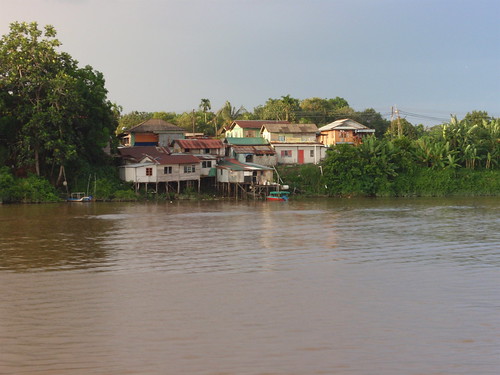
Just today I learned that Kuching has two city halls and two mayors - one, Malay, to the north of the river and the other, Chinese, to the south. I'm having difficulty deciding how to think about this. Such categorisations might seem to be a recipe for division and wastefulness, but in its day-to-day life Kuching provides an image to the observer of people living peaceably, but differently, together. The state of Sarawak recently built a new State Assembly building that is highly visible from the riverside walk. It's extremely grand - though I'm not sure how to describe its ornate architecture - part Islamic, part gothic, part folly, altogether decorated, and very proud.
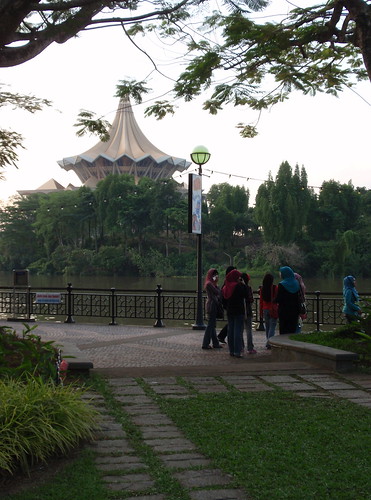
And for the food aficionados - we're eating well. Our hotel does great breakfasts and I seem to have found my favourite combination - fruit followed by excellent bircher muesli and then freshly cooked roti with vegetable curry. How's that for east meets west? Since we've been in Kuching a number of people had recommended eating at the Top Spot, which is near our hotel. I'm not sure what we'd expected, but certainly not the enormous food court style roof-top restaurant seating hundreds of people.

You choose your very fresh seafood from the extraordinary array and it is then cooked for you. We had a flat, John Dory-like white fish steamed with ginger and soy sauce, crisp fried whole prawns in pepper, and quickly stir-fried mixed vegetables including the local edible jungle fern shoots.
Lots more to report, but I'm dropping with tiredness - and the heat! Most of the time I'm bright red and a puddle of sweat. Perhaps vainly, I'm hoping I'll acclimatise a bit.
4 comments:
Oh the restaurant sounds fabulous. Yum!
I know very little about Malaysia - so I know I will learn lots from your holiday!
Thank you for taking time out of your holiday to share it with us - I particularly want to visit the textile museum!
Oh how I would have loved to see inside that textile museum, however you did describe it quite well - sounds so beautiful !
Lovely photos and looks like your both not going to starve over there, although getting used to the heat may be another story altogether .D
its usually the thought of that heat that stops me from visiting tropical places, but your photos from this exotic part of the world make it look very enticing. what an interesting city!
Post a Comment